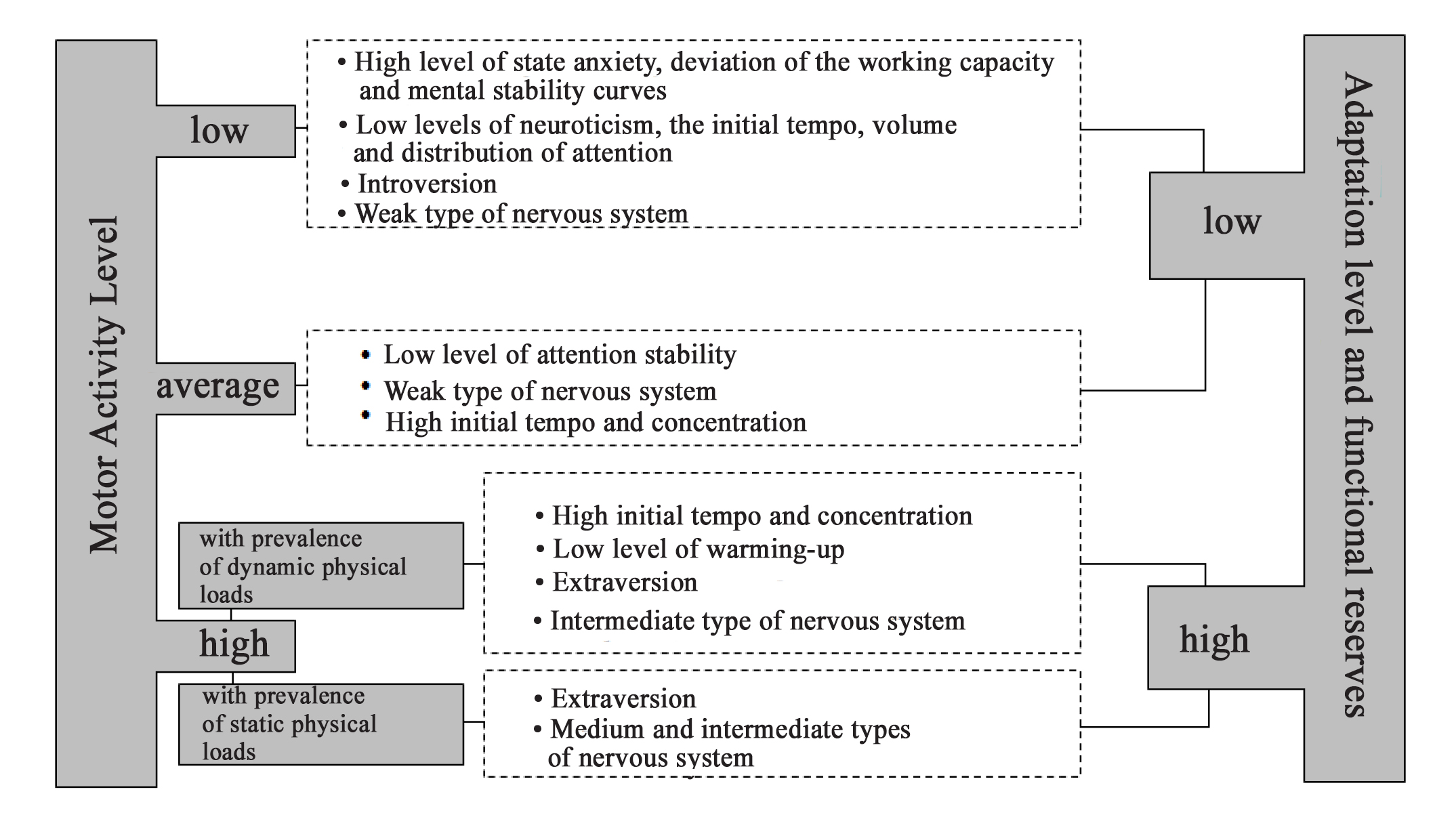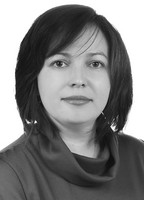Psychophysiological and cognitive features of persons with different levels of motor activity
Фотографии:
ˑ:
PhD A.V. Kabachkova1
Postgraduate G.S. Lalaeva1
Postgraduate A.N. Zakharova1
Professor, Dr.Med. L.V. Kapilevich1, 2
1National Research Tomsk State University, Tomsk
2National Research Tomsk Polytechnic University, Tomsk
Keywords: motor activity, physical load, cognitive activity, attention, type of nervous system.
Introduction. Sports activities are accompanied by a response from psychomotor, cognitive and psychophysiological functions of the body [2, 5]. Along with the fact that motor activity (MA) has a beneficial effect on the functional status [1], extreme physiological and psychological stress may impair cognitive functions, adaptive and recovery processes in the boy [3, 6]. The level and prevailing nature of MA will largely determine the parameters of the emerging functional system, which should be reflected in the specific features of psychophysiological and cognitive parameters. Thus, study of psychophysiological and cognitive status of persons with different levels of motor activity currently remains relevant.
Objective of the research was to study psychophysiological and cognitive features of persons with different levels of motor activity.
Methods and structure of the study. The study involved men aged 17-20 years (n=50) who comprised 4 homogeneous groups different by their MA level [4]:
1) low level of MA (LMA) – less than 9 hours per week (n=10);
2) average level of MA (AMA) – 9 hours per week (n=20);
3) high level of MA (HMA) – more than 9 hours per week:
3.1) with a prevalence of dynamic physical loads (HMAd) - middle-distance track and field athletes having at least the Candidate for Master of Sports title (n=10);
3.2) with a prevalence of static physical loads (HMAs) - powerlifters with at least the Candidate for Master of Sports title (n=10).
The impact of stress factors caused by sitting for tests and examinations was out of the question. The research was conducted before lunch time. None of the subjects had a history of acute and chronic pathologies at the time. Psychophysiological and cognitive states of the students were assessed by «NS-Psychotest» equipment and software based on the data obtained from tapping tests, Schulte tables, STAI, Eysenck personality test and «Volume and distribution of attention» test.
The data were statistically processed using STATISTICA 8.0 software and included a calculation of descriptive sample parameters, a normality test in frequentist statistics (Shapiro-Wilks test), a comparative analysis of independent (Mann-Whitney test) and dependent (Wilcoxon test) samples. P<0.05 was taken as a statistically significant difference.
Results and discussion. State and trait anxiety in persons with different levels of motor activity. The proportion of persons with a high level of state anxiety by the Spielberger anxiety scale was about the same in all the groups (85% on average), and in the LMA group all the subjects had high state anxiety levels. High levels of trait anxiety were about the same in all the groups (65% on average).
Features of temperament in persons with different levels of motor activity. On the extra-introversion scale of the personality test it was found that introverts dominate in the LMA group (80%), while extraverts dominate in the other groups (over 50%). It also turned out there were by 20% more persons with low levels of neuroticism in the LMA group compared with the subjects in the other groups.
Intensity of nervous processes in persons with different levels of motor activity. Analysis of the tapping test results indicates that the initial pace level in the HMAd group (8.6 Hz on average) was higher than that in the other groups (p<0.05). The lowest level of the initial pace was found in the LMA group. Deviation of the working capacity curve did not differ significantly in the groups ranging from -33.60 to -31 c.u.; however, it was the largest in the LMA subjects. No differences were identified in the nervous system stability (-0.25, -0.3 c.u. on average in all the groups). Subjects from the LMA and AMA groups had a weak type of nervous system, those from the HMAd group – intermediate and HMAs – intermediate and medium types.
Attention in persons with different levels of motor activity. Analysis of the results of tests using the Schulte tables showed that the warming-up level in the LMA group – 1.24 (1.10; 1.20) c.u. – was significantly higher statistically than in the other groups. At the same time this value in the HMAd group (1.1 c.u. on average) was significantly higher statistically than in the AMA group. Thus, LMA and HMAd groups’ representatives need time to prepare for the performance of the main work. Representatives of the HMAd group had lower concentration skills – 26.4 (22.8; 38.5) c.u. – than in the AMA group (36.8 (34.5; 44.4) c.u.) and in the LMA group – 31.59 (26.8; 35.20) c.u.), and in the HMAs group, on the contrary, it was higher – 42.1 (40.3; 43.8) c.u. Representatives of the AMA group that made more mistakes during the test compared with the other groups have an insufficient (average) level of attention stability.
When analyzing the «Volume and distribution of attention» test results it was found that representatives of almost all of the studied groups except LMA (60%) had a 100% of the attention volume. Attention distribution in the LMA group was also much worse than in the other groups.
Conclusion. Athletes representing cyclic sports have better developed concentration skills, at the same time showing low warming-up levels and a high initial pace during tapping test execution. All this indicates higher lability of the nervous processes. Almost none of the indicators of endurance sports athletes differ from those of the AMA group. At the same time their attention stability is higher. Differences in many psychophysiological and cognitive indicators were found in representatives of the LMA group compared with the other studied groups. High state anxiety, low neuroticism, low initial pace, low working capacity and high mental stability were observed in this group. Cognitive features of the volume and distribution of attention in the LMA group also turned out to be significantly lower compared with those of the other groups’ representatives (see Figure 1).
Mechanisms underlying differences in psychophysiological and cognitive characteristics of the representatives of individual specializations are obviously connected with the features of their nervous organization, the leading role of which is given to peculiarities of the cerebral cortex activity formed by regular repetition of particular motor activity patterns. This, in turn, is connected with the specifics of the training process and impacts adaptive, compensatory, psychological and rehabilitation properties of representatives with different levels of motor activity.
References
- Apanasenko G.L., Popova L.A. Meditsinskaya valeologiya [Medical valueology]. Rostov-on/D.: Feniks, 2000, 248 p.
- Aseev D.N., Barkova V.L. Funktsional'nye sostoyaniya v strukture sportivnoy deyatelnosti [Functional status in the structure of sports activities]. Uch. zapiski RGSU, 2011, no. 6, pp. 268-272.
- Balanev D.Y., Kapilevich L.V., Shil'ko V.G. Perspektivy primeneniya metodov monitoringa dvigatelnoy aktivnosti cheloveka v sporte [Perspectives of application of motor activity monitoring techniques in sport]. Teoriya i Praktika Fizicheskoy Kultury, 2015
- Balyuk V.G., Kolmogorov S.V., Timokhova N.V. Zavisimost' osnovnykh neyrodinamicheskikh kharakteristik sportsmenov ot vida deyatel'nosti i kvalifikatsii [Effect of type of activity and qualification on athletes' main neurodynamic characteristics]. Fizicheskaya kultura i sport. Ekologiya cheloveka, 2009, no. 5, p. 209.
- Kabachkova A.V., Fomchenko V.V., Frolova J.S. Dvigatel'naya aktivnost studencheskoy molodezhi [Motor activity of students]. Vestnik Tomskogo gosudarstvennogo universiteta, 2015, no. 392, pp. 175-178.
- Kapilevich L.V. Fiziologicheskie mekhanizmy koordinatsii dvizheniy v bezopornom polozhenii u sportsmenov [Physiological mechanisms of motor coordination in athletes in unsupported position]. Teoriya i Praktika Fizicheskoy Kultury, 2012, no. 7, pp. 45-48.
- Koshelskaja E.V., Kapilevich L.V., Bajenov V.N., Andreev V.I., Buravel, O.I. Physiological and biomechanical characteristics of the kick and goal techniques of football players. Bulletin of Experimental Biology and Medicine, 2012, vol. 153, I. 2, P.266-268.
- Lebedeva I.S. Nekotorye strukturno-funktsionalnye osobennosti mozolistogo tela i protsessy obrabotki slukhovoy informatsii v norme i na rannikh etapakh shizofrenii [Some structural-functional features of corpus callosum and auditory information processing in health and at early stages of schizophrenia]. Funktsionalnaya mezhpolusharnaya asimmetriya i plastichnost mozga, 2012, pp. 317-320.
- Strelnikova J.Y. Vremennye kharakteristiki poznavatelnykh protsessov kak faktor povysheniya rezultativnosti obucheniya v vysshey shkole [Temporal characteristics of cognitive processes as a factor of academic progress in higher education]. Vestnik Sankt-Peterburgskogo universiteta MVD Rossii, 2010, no. 1, pp. 228–235.
- Lalaeva G.S., Zakharova A.N., Kabachkova A.V., Mironov A.A., Kapilevich L.V. Psikhofizicheskie osobennosti sportsmenov tsiklicheskikh i silovykh vidov sporta [Psychophysiological features of cyclic and endurance athletes]. Teoriya i Praktika Fizicheskoy Kultury. 2015, no. 11, pp. 73-75.

Figure – Psychophysiological features of persons with different levels of motor activity
Note – type of nervous system was determined based on psychomotor performance during the tapping test
Corresponding author: kapil@yandex.ru



